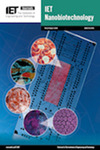
Electrical and electronic engineers have a long and illustrious history of contributing new theories and technologies to the biomedical sciences. This includes the cable theory for understanding the transmission of electrical signals in nerve axons and muscle fibres; dielectric techniques that advanced the understanding of cell membrane structures and membrane ion channels; electron and atomic force microscopy for investigating cells at the molecular level.
Other engineering disciplines, along with contributions from the biological, chemical, materials and physical sciences, continue to provide groundbreaking contributions to this subject at the molecular and submolecular level. Our subject now extends from single molecule measurements using scanning probe techniques, through to interactions between cells and microstructures, micro- and nano-fluidics, and aspects of lab-on-chip technologies. The primary aim of IET Nanobiotechnology is to provide a vital resource for academic and industrial researchers operating in this exciting cross-disciplinary activity. We can only achieve this by publishing cutting edge research papers and expert review articles from the international engineering and scientific community. To attract such contributions we will exercise a commitment to our authors by ensuring that their manuscripts receive rapid constructive peer opinions and feedback across interdisciplinary boundaries.
IET Nanobiotechnology covers all aspects of research and emerging technologies including, but not limited to:
Fundamental theories and concepts applied to biomedical-related devices and methods at the micro- and nano-scale (including methods that employ electrokinetic, electrohydrodynamic, and optical trapping techniques)
Micromachining and microfabrication tools and techniques applied to the top-down approach to nanobiotechnology
Nanomachining and nanofabrication tools and techniques directed towards biomedical and biotechnological applications (e.g. applications of atomic force microscopy, scanning probe microscopy and related tools)
Colloid chemistry applied to nanobiotechnology (e.g. cosmetics, suntan lotions, bio-active nanoparticles)
Biosynthesis (also known as green synthesis) of nanoparticles; to be considered for publication, research papers in this area must be directed principally towards biomedical research and especially if they encompass in vivo models or proofs of concept. We welcome papers that are application-orientated or offer new concepts of substantial biomedical importance
Techniques for probing cell physiology, cell adhesion sites and cell-cell communication
Molecular self-assembly, including concepts of supramolecular chemistry, molecular recognition, and DNA nanotechnology
Societal issues such as health and the environment
Special issues. Call for papers:
Smart Nanobiosensors for Next-generation Biomedical Applications - https://digital-library.theiet.org/files/IET_NBT_CFP_SNNBA.pdf
Selected extended papers from the International conference of the 19th Asian BioCeramic Symposium - https://digital-library.theiet.org/files/IET_NBT_CFP_ABS.pdf
《Iet Nanobiotechnology》是一本由Wiley出版商出版的专业工程技术期刊,该刊创刊于2007年,刊期Bi-monthly,该刊已被国际权威数据库SCIE收录。在中科院最新升级版分区表中,该刊分区信息为大类学科:工程技术4区,小类学科:生化研究方法 4区;纳米科技 4区;在JCR(Journal Citation Reports)分区等级为Q1。该刊发文范围涵盖BIOCHEMICAL RESEARCH METHODS等领域,旨在及时、准确、全面地报道国内外BIOCHEMICAL RESEARCH METHODS工作者在该领域取得的最新研究成果、工作进展及学术动态、技术革新等,促进学术交流,鼓励学术创新。2023年影响因子为3.8,平均审稿速度 12周,或约稿 。
中科院分区(当前数据版本:2023年12月升级版)
| 大类学科 | 分区 | 小类学科 | 分区 | Top期刊 | 综述期刊 |
| 工程技术 | 4区 | BIOCHEMICAL RESEARCH METHODS 生化研究方法 NANOSCIENCE & NANOTECHNOLOGY 纳米科技 | 4区 4区 | 否 | 否 |
中科院分区(当前数据版本:2022年12月升级版)
| 大类学科 | 分区 | 小类学科 | 分区 | Top期刊 | 综述期刊 |
| 工程技术 | 4区 | BIOCHEMICAL RESEARCH METHODS 生化研究方法 NANOSCIENCE & NANOTECHNOLOGY 纳米科技 | 4区 4区 | 否 | 否 |
中科院分区(当前数据版本:2021年12月旧的升级版)
| 大类学科 | 分区 | 小类学科 | 分区 | Top期刊 | 综述期刊 |
| 工程技术 | 4区 | BIOCHEMICAL RESEARCH METHODS 生化研究方法 NANOSCIENCE & NANOTECHNOLOGY 纳米科技 | 4区 4区 | 否 | 否 |
中科院分区(当前数据版本:2021年12月基础版)
| 大类学科 | 分区 | 小类学科 | 分区 | Top期刊 | 综述期刊 |
| 工程技术 | 4区 | BIOCHEMICAL RESEARCH METHODS 生化研究方法 NANOSCIENCE & NANOTECHNOLOGY 纳米科技 | 4区 4区 | 否 | 否 |
中科院分区(当前数据版本:2021年12月升级版)
| 大类学科 | 分区 | 小类学科 | 分区 | Top期刊 | 综述期刊 |
| 工程技术 | 4区 | BIOCHEMICAL RESEARCH METHODS 生化研究方法 NANOSCIENCE & NANOTECHNOLOGY 纳米科技 | 4区 4区 | 否 | 否 |
中科院分区(当前数据版本:2020年12月旧的升级版)
| 大类学科 | 分区 | 小类学科 | 分区 | Top期刊 | 综述期刊 |
| 工程技术 | 4区 | BIOCHEMICAL RESEARCH METHODS 生化研究方法 NANOSCIENCE & NANOTECHNOLOGY 纳米科技 | 4区 4区 | 否 | 否 |
名词释义:中科院分区是中国科学院国家科学图书馆制定,中科院分区目前分为基础版和升级版(试行),基础版先将JCR中所有期刊分为13大类学科,每个学科分类按照期刊的3年平均影响因子高低,分为4四个区;升级版将期刊分为18个大类学科,涵盖数学、物理与天体物理、化学、材料科学、地球科学等大类学科;升级版设计了“期刊超越指数”取代影响因子指标。期刊超越指数即本刊论文的被引频次高于相同主题、相同文献类型的其它期刊的概率。
JCR分区(当前数据版本:2023-2024年最新版)
| 按JIF指标学科分区 | 收录子集 | 分区 | 排名 | 百分位 |
| 学科:BIOCHEMICAL RESEARCH METHODS | SCIE | Q1 | 15 / 85 |
82.9% |
| 学科:NANOSCIENCE & NANOTECHNOLOGY | SCIE | Q3 | 71 / 140 |
49.6% |
| 按JCI指标学科分区 | 收录子集 | 分区 | 排名 | 百分位 |
| 学科:BIOCHEMICAL RESEARCH METHODS | SCIE | Q4 | 67 / 85 |
21.76% |
| 学科:NANOSCIENCE & NANOTECHNOLOGY | SCIE | Q3 | 87 / 140 |
38.21% |
名词释义:JCR(Journal Citation Reports)由科睿唯安公司(前身为汤森路透)开发,JCR分区将期刊分为176个学科。该排名根据当年不同学科的影响因子,分为Q1、Q2、Q3、Q4四个区域。 Q1代表不同学科进行分类可以影响细胞因子前25%的期刊,以此作为类推,Q2是前25%-50%的期刊,Q3是前50%-75%的期刊,Q4是后期75%的期刊。
Cite Score 排名
| CiteScore | SJR | SNIP | 学科类别 | 分区 | 排名 | 百分位 |
| 6.2 | 0.512 | 0.707 | 大类:Engineering 小类:Electrical and Electronic Engineering | Q2 | 202 / 797 |
74% |
| 大类:Engineering 小类:Electronic, Optical and Magnetic Materials | Q2 | 77 / 284 |
73% |
|||
| 大类:Engineering 小类:Biotechnology | Q2 | 116 / 311 |
62% |
名词释义:CiteScore 是在 Scopus 中衡量期刊影响力的另一个指标,其作用是测量期刊的篇均影响力。当年CiteScore 的计算依据是期刊最近4年 (含计算年度) 的被引次数除以该期刊近四年发表的文献数,文献类型包括:文章、评论、会议论文、书籍章节和数据论文,社论勘误表、信件、说明和简短调查等非同行评议的文献类型均不包含在内。
1、Iet Nanobiotechnology期刊级别中等偏靠后,影响力一般,竞争相对来说不算太难,过审也相对较容易,建议您可以关注。研究方向为工程技术 - 纳米科技,建议您投递与此行业相关的稿件,以兔被拒稿耽误您的时间。建议稿件控制10页以上,4600单词字数以上(未翻译中文字数8600字数以上);文章撰写语言为英语;(单栏格式,单倍行距,内容10号字体,文章内容包含:题目,所有作者姓名、最高学位,作者单位(精确到部门),通信作者邮箱,摘要,关键词,内容,总结,项目基金,参考文献,所有作者相片+简介)。
2、该期刊近年没有被列入国际期刊预警名单(2021年12月发布的2021版),广大学者可以放心选择。鼓励提交以前未发表的文章,禁止一稿多投;拒绝抄袭、机械性的稿件;平均审稿速度 12周,或约稿 。
3、稿件重复率控制10%以内,论文务必保证原创性、图标、公式、引文等要素齐备,已发表或引用过度的文章将不会被出版和检索。
4、稿件必须有较好的英语表达水平,有图,有表,有公式,有数据或设计,有算法(方案,模型),实验,仿真等。
5、参考文献控制25条以上,参考文献引用一半以上控制在近5年以内;图表分辨率必须达到300dpi;参考文献与文献综述能反映国际研究前沿。
6、若您想联系Iet Nanobiotechnology出版商,请根据该地址联系:WILEY, 111 RIVER ST, HOBOKEN, USA, NJ, 07030-5774。
7、如果你想快速在SCI期刊发表,可以咨询本站的客服老师,我们将为你提供SCI期刊全过程管理服务,不成功不收取任何费用。
| 影响因子 | h-index | Gold OA文章占比 | 研究类文章占比 | OA开放访问 | 平均审稿速度 |
| 3.8 | 31 | 69.12% | 77.14% | 开放 | 12周,或约稿 |
IF值(影响因子)趋势图
中科院JCR分区趋势图
名词释义:影响因子 简称IF,是汤森路透(Thomson Reuters)出品的期刊引证报告(Journal Citation Reports,JCR)中的一项数据。 即某期刊前两年发表的论文在该报告年份(JCR year)中被引用总次数除以该期刊在这两年内发表的论文总数。这是一个国际上通行的期刊评价指标,是衡量学术期刊影响力的一个重要指标。
| 中科院同小类学科热门期刊 | 影响因子 | 中科院分区 | 浏览次数 |
| International Journal Of Hydrogen Energy | 8.1 | 2区 | 15458 |
| Journal Of Sustainable Cement-based Materials | 4.7 | 3区 | 10110 |
| Lab On A Chip | 6.1 | 2区 | 6010 |
| Case Studies In Thermal Engineering | 6.4 | 2区 | 5256 |
| Engineering Construction And Architectural Management | 3.6 | 2区 | 4502 |
| Chemical Engineering Journal | 13.3 | 1区 | 4083 |
| Journal Of Building Engineering | 6.7 | 2区 | 3973 |
| Aerospace | 2.1 | 3区 | 3644 |
| Separation And Purification Technology | 8.1 | 1区 | 3366 |
| Cirp Journal Of Manufacturing Science And Technology | 4.6 | 2区 | 3349 |
本站合法持有《出版物经营许可证》,仅销售经国家新闻出版署批准的合法期刊,不是任何杂志官网,不涉及出版事务。本站仅提供有限咨询服务,需要用户自己向出版商投稿且没有绿色通道,是否录用一切以出版商通知为准。提及的第三方名称或商标,其知识产权均属于相应的出版商或期刊,本站与上述机构无从属关系,所有引用均出于解释服务内容的考量,符合商标法规范。本页信息均由法务团队进行把关,若期刊信息有任何问题,请联系在线客服,我们会认真核实处理。 若用户需要出版服务,请联系出版商:WILEY, 111 RIVER ST, HOBOKEN, USA, NJ, 07030-5774。